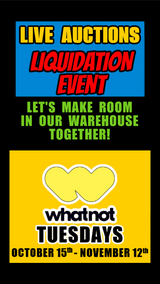Should I Get a Warehouse for My eCommerce Online Business? Leasing a Warehouse for Beginners
If you are starting an online business, or maybe you already have an online business, you are wondering if getting a warehouse is a right choice for you. Today we are going to go over the Top 10 things you must know about a commercial warehouse lease for your Amazon, eBay or online business so you can make an informed decision. Let's begin...
In no particular order, these are the utmost imperative factors to take into consideration when deciding if you need a warehouse, storage unit or similar and picking the correct warehouse for your needs:
1. COSTS: The internet contains tons of “fake news”; yes, a warehouse *can* cost “as little as 20 cents per square foot!” but this is typically ONLY IF you are getting a MASSIVE warehouse over 100,000 sqft...trust me, you do NOT need this much space if you are currently trying to decide if you need a warehouse or not. 100,000 sqft is damn near the size of a Costco or Sams Club. If you are just starting out, a 1,000 sqft-1,500 sq is absolutely fantastic for your first 2 or 3-year-lease. If for some insane reason you have the 1-in-a-million business that skyrockets into success in the first year you can sublease your space or you can just pay off your lease so you can move. Again, trust me, you won’t need to move in the first 2+ years. With correct shelving and organization, you can fit an absolute TON of stuff into 1,250-ish sqft IF you pick the right type of space!. We will discuss this more throughout the rest of this list. So, if you are looking to get a warehouse around the 1,250-ish sqft range you will likely be paying around $1,500 a month rent, depending on neighborhood and some other factors.
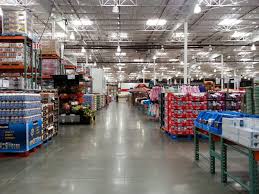
2. ADEQUATE PLUGS / OUTLETS and appropriate voltage / wattage because you can't operate a business when the power supply can't handle it or if there isn't enough outlets!! You will need multiple power outlets for your computer, printer, thermal printer, internet modem, chargers for power tools and phones and other stuff. I assume you will be taking photos of products so you'll need photo lights and so on. THINGS NOBODY TELLS YOU: Before you sign a lease, You MUST TEST THE OUTLETS to make sure they work!!! Bring a phone charger with you. Test each outlet by plugging the charger into the wall and see if it works to charge your phone.
If you find outlets that don't function properly insist that the landlord has the electric fully repaired before you move in. Be sure to have this written into the lease because electricians are incredibly expensive. You should also insist that rent will not be due in full of the property cannot pass electrical inspection.
3. USABLE SPACE: When determining if a lease is right for you, you need to consider the Price Per sqft… and the price needs to be determined based on how much foot you can truly use to store, sell and ship stuff. Things to note:
Staircases / Mezzanines - typically the space under a staircase isn’t truly “usable”. Maybe you can store some stuff there but you can’t truly “use” it. This means, if the space you are looking at is “1,300 sqft” you need to deduct the sq footage the staircase takes up. TIP: Make sure that if you have a staircase, you buy 3 pool noodles and slice half way through horizontally (pretend you are making a hotdog and you need to slice the bun). Slip the slit part of the pool noodles onto the lip of the underside of the staircase because you (or someone else) WILL bash their head on it when walking under it. I guarantee it!!!! A “staircase concussion” IS preventable!
Bathroom(s) Location(s) - If you have a closet in a bad location you can put a shelf in front of it and never use it or take the closet door off and have an open space, but if the bathroom is in a bad location, your S.O.L (pun intended). There always has to be a clear pathway to the restroom, so you have to plan out your layout around it. TIP: If possible, try to get a restroom that is technically in someone else's space, because this saves you SQFT. For example, think of it like this:
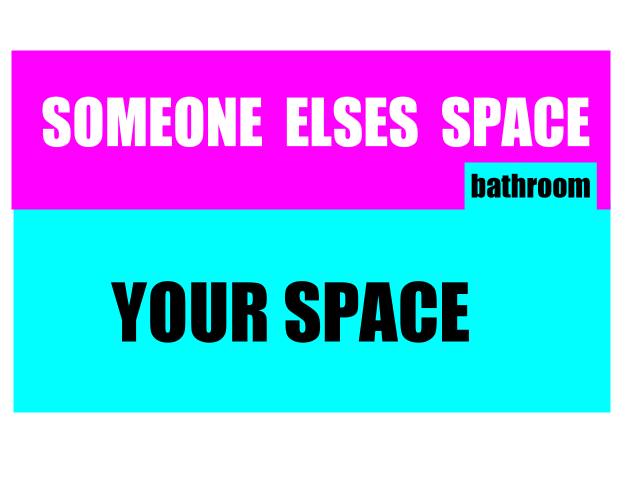
You want to avoid spaces like this:
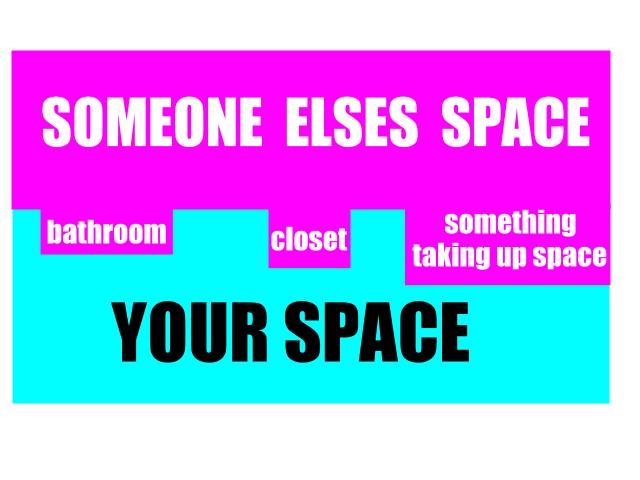
Because WTF are you going to do with these spaces???:
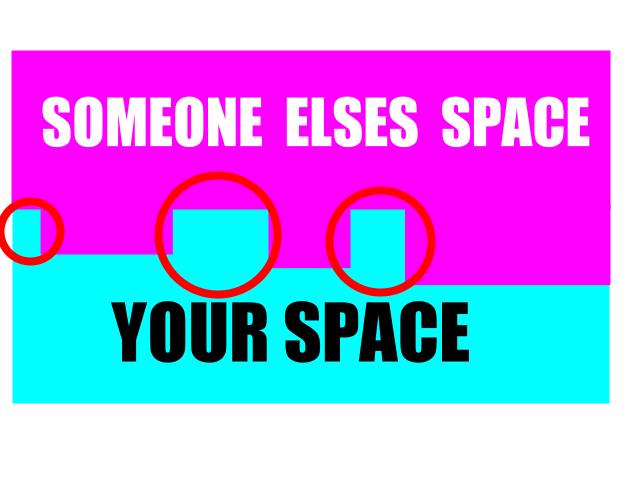
TIP: ANY TIME YOU EVER GO LOOK AT A SPACE you should be bringing a TAPE MEASURE and a pad of paper. You need to measure the space every which way because you might find out that the advertisement for leasing was inaccurate and you do not want to overpay but, ADDITIONALLY, you need to figure out how you are going to make it work. Let’s look at this space again, this time with measurements:
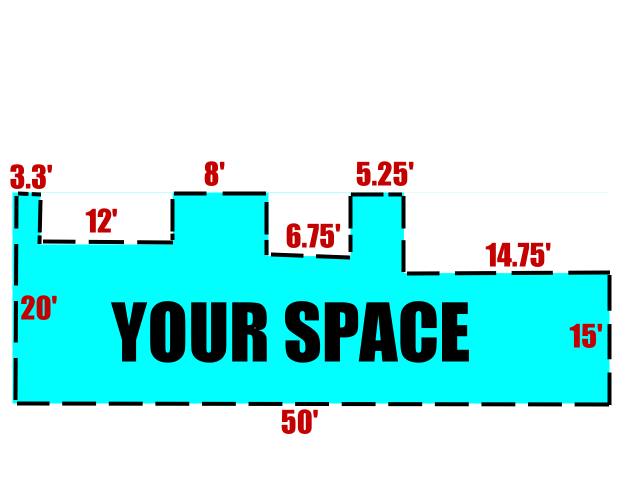
Be sure to mark off where unusable space is (doors, restroom, closets you need, furnace, etc. Now you end up with this (unusable space is marked with yellow “X”):
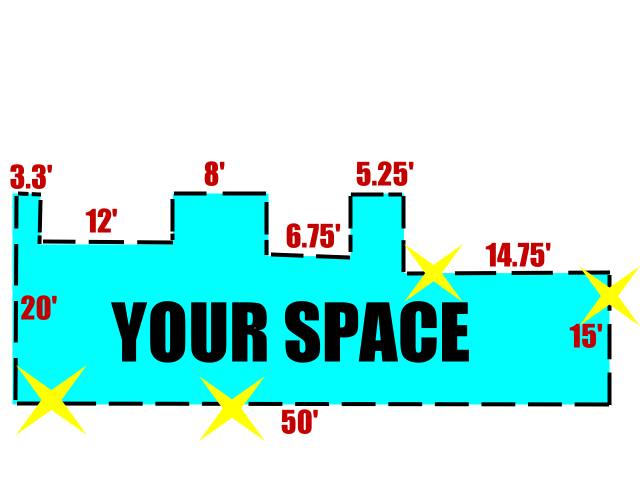
Next you have to figure out how you are going to use the space to store merchandise. Let’s say the size of each shelf is 48” long x 16" wide x 72" tall. As we can see from the diagram, the wall is 50 feet long by 20 feet wide, but there are a lot of oddly shaped indents as well as randomly placed unusable spaces. So I am going to see how I can make this work for my shelving. The green squares represent shelving:
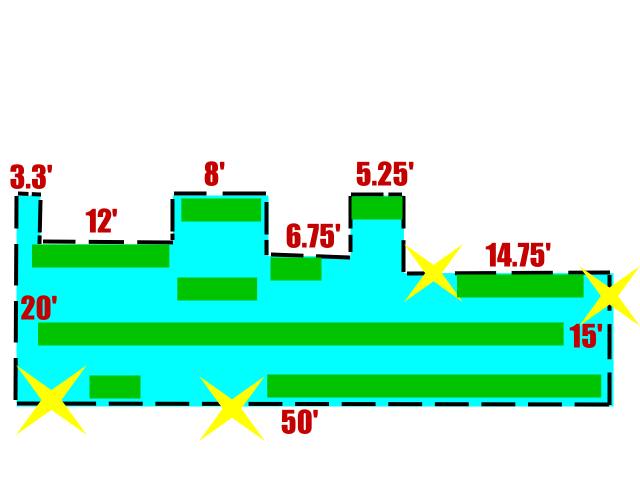
Of course I could turn the shelves vertically instead of horizontally and see if I could fit more in. However, the layout of the unusable space definitely hinders my ability to have a nice layout. I would be better off finding a space that costs more but is an actual rectangle so I have substantially more usable sqft. TIP: When determining space in between shelves, you have to plan ahead for being ADA and OSHA compliant or the city can deny you your Certificate of Occupancy. The minimum walkway distance between shelves must be 36" (as of 2.14.20 in Michigan. This information could change so be sure to check with your city and state before you officially start setting up shop!). This means if the shelf is 16" wide and you must have 36" in between shelves; a shelf + a 36" walkway space + another shelf is going to take up 68" of floor area!
4. MORE COSTS: General Maintenance & Repairs: For example, every commercial space needs maintenance for the building, the roof, the exterior walls, the parking lot, etc. Is snow plowing included in the rent? If the roof leaks is the repair included in rent (landlord responsibility)? Property Taxes? If the heat goes out, is that included? Trash removal / dumpster emptying? What about fixing parking lot potholes? Some landlords do include this in rent. Other landlords will designate what they will pay for and what you will pay for. As an example, at our current warehouse we had to pay for the replacement of a $4,000 commercial air conditioning system plus installation (that sucked because the thing was already 30 years old when we signed the lease, so basically the landlord got a free AC unit). Other landlords (like in our previous warehouse) would add up all the maintenance for all of the tenants and divide it by the total number of tenants then slam you with a bill for $2,000 - $12,000 once per year. This was one of the main reasons we paid off our lease early and left. The insane additional expenses all the time were so out of control. Anyways, if the stuff is not included in rent, you gotta factor in all the little costs like dumpster fees ($150 a month), salt / snow removal (seasonal, $100 a month), general repairs, etc ($250 a month).
5. TWO TYPES OF INSURANCE: The building itself has to be insured. Once again, this may be included in your rent or the landlord may send you a bill annually. Our current landlord includes it in rent. Our last wretched landlord would send us a random bill for $800 every year for building insurance.
The second type of insurance you MUST HAVE is business insurance. This means that if the building burns to the ground or if you get robbed or even if a sewer backs up and floods your space with swamp-water, you will be financially covered. Business insurance includes your inventory but also your equipment (computers, printers, signage if applicable, etc). Business insurance also saves your ass if someone slips and falls or if a terminated disgruntled employee breaks all your windows and spraypaints all over your building. Our business insurance costs around $600 a month, but we have a policy that covers over two million dollars in inventory and assets as well as other “riders” that protect us against (frivolous) lawsuits. If you are just starting out you can get a policy for probably under $100 a month.
6. UTILITIES & SHARED UTILITIES: If you are renting a space in a shared warehouse you will likely have some of your own utilities but you will likely share some utilities too. Every single space I have ever leased has had some shared utilities, which is pretty terrible if you are the business that doesn’t use a lot of utilities. If the utilities are shared you will typically pay the divided cost to the landlord in addition to your rent. If the utility is in your name you will pay it like a regular utility bill. Regardless of how it is paid, you can assume you will be paying for water, electricity, gas (if applicable), internet, etc. Here’s what we pay for over 7,500 sq ft: Water: $125 quarterly, electricity: $500/mo, gas: $600 during cold months, $65 during summer. Internet: $200 a month for high speed, business edition. For more details on Shared Utilities be sure to read our article XXXXXXXXXXXXXXX5 Things Nobody Tells You About a Commercial Warehouse Lease for Your eCommerce Business. XXXXXXXXXXXXXXXXXXXXXXx
7. SHIPPING & RECEIVING: If you have an online business you need to ship orders. There are so many advertisements for “warehousing space” on the internet that offer STORAGE space but are absolutely NOT practical for running a business that ships within.
After you have shipped, how do you plan to have the parcels be put into transit? Do you plan to load them in your vehicle and drive them to USPS / Fed Ex / UPS? Or are you having the carrier pickup from you? If the carrier is picking up for you, are you legally allowed to have pickups at this location? If you are leasing actual “storage” you may not be allowed to run a business out of it. If you are allowed to have pickups, WILL the carrier pickup from this location?
8. THINGS TO AVOID LIKE THE PLAGUE:
- AVOID a warehouse with entry / exit stairs!! Even if there are only “a couple steps”, JUST SAY NO. Warehousing = parcels, boxes, shipments and deliveries need to be moved in and out. Years ago I broke my ankle falling down “just a couple" stairs!! NEVER get a warehouse with stairs!
- AVOID any warehouse that does not have parking that allows you (or a carrier) to pull directly up to (or inside) the building.
- AVOID warehouses that are not temperature controlled! Even if you feel like you can just use a space heater or a fan, you can completely DESTROY your products! Cosmetics, candles and other merchandise will MELT during the hot months. Lotions, skin care and other liquids will FREEZE during the winter! Even if you only plan to sell clothing (or whatever), fabrics will absorb odor in heat. You don't want to ship your buyers stink sweaters or sweat-scented jeans!
9. LOCATION: Location is less important when you lease a warehouse if you do not plan to offer retail within your warehouse. BUT, you still have to drive there and home daily. The further away from your home the warehouse is the more TIME you will INVEST in transit. Time spent driving is the most wasted asset. I strongly encourage you to either get a warehouse within 10 minutes drive from your home or move to be close to your warehouse. NEVER lease a property that is over 35 minutes away. Since you are the owner of this business, you need to be there at the drop of a dime, not 45 minutes later.
10. ABILITY TO CONDUCT BUSINESS: Every eCommerce must have lightning-fast internet. Before you sign a lease find out what companies offer internet to that exact address (TIP: BE SURE TO CHECK!!! Are there internet lines? Where is the closest internet tower located? In many commercial locations there are only one or two providers available. We ran into this issue at our first warehouse. If the ONLY internet you can get is crappy AT&T Uverse and every page load takes 8 seconds, providing if the internet doesn’t cut-out, you are going to spend twice as long working. Time = Money! The quicker you can work the more money you will make. You want to have blazing fast internet at your space. You want to make sure a business edition plan is offered, so CALL your favorite internet company and ASK if they offer service to the exact address you think you’re going to lease. Another TIP: Always sign up for your internet at your warehouse as a Business Account, even if it's a little more expensive because internet companies prioritize businesses. If your business internet goes out they will come out within 4 hours and fix it!!
Love this blog post? Check out our other tips and detailed guides:
- What is Best to Sell Online? How to Pick Inventory for Your Internet Store
- Complete Guide to Amazon Ungating for Beginners
- How Wholesale, Liquidations and Store Returns Work: How We Get Our Inventory
- Top 5 Reasons You Aren't Getting Ungated on Amazon
- How to Shelve and Store Your Inventory! Complete Guide
- 20+ Mens Items that SHIP CHEAP (First Class)
- 25+ Womens Items that SHIP CHEAP (First Class)
- 30+ Kids Items that SHIP CHEAP! (First Class Mail)
- Learn How to Upsell Like a Pro
- Genuine Advice for New Online Sellers
- What is Best to Sell Online?
- Store Returns: How to Deal with a Hole in Clothing
- SITES TO SELL ON OTHER THAN AMAZON OR EBAY: Bonanza - An Honest Review
- Alternatives to eBay & Amazon Selling: eBid - a Brutally HONEST REVIEW
- HONEST REVIEW: Selling on Sears.com Marketplace (Amazon / eBay Alternatives 2020)
- BEST Amazon Alternative for Sellers: Walmart.com - Its FREE!! Plus FREE Marketing! Everything You Need to Know
- SITES TO SELL ON OTHER THAN AMAZON OR EBAY Sears vs Walmart vs BriskSale
- Amazon Ungating Checklist
- Watch us build our Warehouse! 3 years in 5 minute video!
- What is a Purchase Order & How to Get One
- Check out our Free Amazon Ungating Terminology Dictionary!
- Or Read The Ultimate Wholesale Dictionary (Yes, we literally wrote a Dictionary!)
- Complete Guide to TYPES OF LIQUIDATIONS
- Pallets: How Much Does a Clothing Pallet Cost?
- What is a BOL and How to Find Yours
- What is a PRO Number and How to Find Yours
- How to Get a Resellers Permit / Resale Certificate
- What is an EIN and How to Get One
- What is an LLC and How to Get One
- How to Create an Awesome Company Logo FAST and FREE
- Help! My Inventory is Priced Super Low and Still Isn't Selling!
- Before You Sign a Commercial WAREHOUSE Lease Read these Secrets! 5 Things Nobody Ever Tells You!
- Learn About Our Invoices
- HELP! I Missed USPS Delivery! How Can I Get My Parcel?!
- Or, TOUR OUR WAREHOUSE https://bigbrandwholesale.com/about-our-warehouse/
Recent Posts
-
WhatNot LIVE AUCTIONS LIQUIDATION EVENT! October 15th - Nov 12th!
We are doing a MASSIVE liquidation auction event on WhatNot! Every TUESDAY from October 15th thr …2nd Oct 2024 -
MASSIVE NEWS! 4 HUGE UPDATES Coming to Big Brand Wholesale.com!
We have TONS of exciting news! Check out our Facebook video from July 12th 2024 (below) then keep r …22nd Jul 2024 -
3 COMPANIES PRETENDING TO BE BigBrandWholesale.com! DO NOT ORDER THROUGH IMPOSTERS!
IMPOSTERS! BE CAREFUL!! DON’T BE FOOLED! We now have at least 3 different people PRETENDING to …23rd Dec 2023


